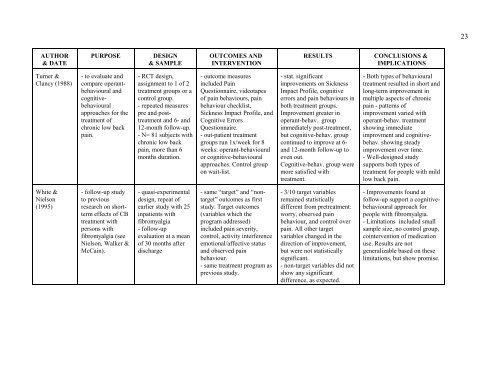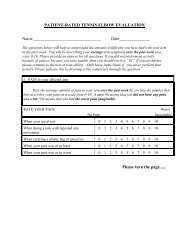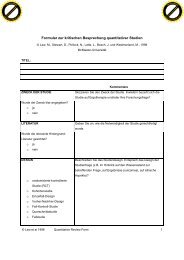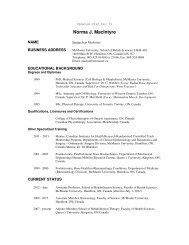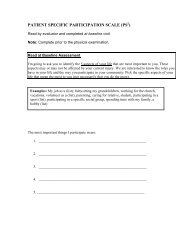The effectiveness of cognitive-behavioural interventions with people ...
The effectiveness of cognitive-behavioural interventions with people ...
The effectiveness of cognitive-behavioural interventions with people ...
Create successful ePaper yourself
Turn your PDF publications into a flip-book with our unique Google optimized e-Paper software.
23AUTHOR& DATEPURPOSEDESIGN& SAMPLEOUTCOMES ANDINTERVENTIONRESULTSCONCLUSIONS &IMPLICATIONSTurner &Clancy (1988)- to evaluate andcompare operant<strong>behavioural</strong>and<strong>cognitive</strong><strong>behavioural</strong>approaches for thetreatment <strong>of</strong>chronic low backpain.- RCT design,assignment to 1 <strong>of</strong> 2treatment groups or acontrol group.- repeated measurespre and posttreatmentand 6- and12-month follow-up.- N= 81 subjects <strong>with</strong>chronic low backpain, more than 6months duration.- outcome measuresincluded PainQuestionnaire, videotapes<strong>of</strong> pain behaviours, painbehaviour checklist,Sickness Impact Pr<strong>of</strong>ile, andCognitive ErrorsQuestionnaire.- out-patient treatmentgroups run 1x/week for 8weeks: operant-<strong>behavioural</strong>or <strong>cognitive</strong>-<strong>behavioural</strong>approaches. Control groupon wait-list.- stat. significantimprovements on SicknessImpact Pr<strong>of</strong>ile, <strong>cognitive</strong>errors and pain behaviours inboth treatment groups.Improvement greater inoperant-behav.. groupimmediately post-treatment,but <strong>cognitive</strong>-behav. groupcontinued to improve at 6-and 12-month follow-up toeven out.Cognitive-behav. group weremore satisfied <strong>with</strong>treatment.- Both types <strong>of</strong> <strong>behavioural</strong>treatment resulted in short andlong-term improvement inmultiple aspects <strong>of</strong> chronicpain - patterns <strong>of</strong>improvement varied <strong>with</strong>operant-behav. treatmentshowing immediateimprovment and <strong>cognitive</strong>behav.showing steadyimprovement over time.- Well-designed studysupports both types <strong>of</strong>treatment for <strong>people</strong> <strong>with</strong> mildlow back pain.White &Nielson(1995)- follow-up studyto previousresearch on shorttermeffects <strong>of</strong> CBtreatment <strong>with</strong>persons <strong>with</strong>fibromyalgia (seeNielson, Walker &McCain).- quasi-experimentaldesign, repeat <strong>of</strong>earlier study <strong>with</strong> 25inpatients <strong>with</strong>fibromyalgia- follow-upevaluation at a mean<strong>of</strong> 30 months afterdischarge- same “target” and “nontarget”outcomes as firststudy. Target outcomes(variables which theprogram addressed)included pain severity,control, activity interferenceemotional/affective statusand observed painbehaviour.- same treatment program asprevious study.- 3/10 target variablesremained statisticallydifferent from pretreatment:worry, observed painbehaviour, and control overpain. All other targetvariables changed in thedirection <strong>of</strong> improvement,but were not statisticallysignificant.- non-target variables did notshow any significantdifference, as expected.- Improvements found atfollow-up support a <strong>cognitive</strong><strong>behavioural</strong>approach for<strong>people</strong> <strong>with</strong> fibromyalgia.- Limitations included smallsample size, no control group,cointervention <strong>of</strong> medicationuse. Results are notgeneralizable based on theselimitations, but show promise.


